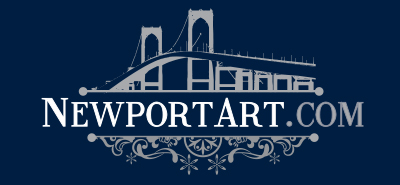 Edward Emerson Simmons was one of the major painters of the American Renaissance, the post-Civil War movement that stressed the inter-relatedness of architecture, painting, sculpture and interior design. His career progressed through Impressionism, but retrospectively his primary distinction is for his mural work, especially the murals he did for the 1893 Chicago Columbian Exposition.
Edward Emerson Simmons was one of the major painters of the American Renaissance, the post-Civil War movement that stressed the inter-relatedness of architecture, painting, sculpture and interior design. His career progressed through Impressionism, but retrospectively his primary distinction is for his mural work, especially the murals he did for the 1893 Chicago Columbian Exposition.
Simmons was born in Concord, Massachusetts, in 1852. His father, George Frederick Simmons, a Unitarian minister, died when Simmons was three. Simmons’ mother, Mary Emerson Ripley, was a cousin of Ralph Waldo Emerson, who was a Concord neighbor. Simmons, who had a very spartan but cultured childhood, entered Harvard in 1870 and after graduation in 1874, took a few odd jobs in New York City, Chicago and Cincinnati. In 1875, he went to California where he wrote a drama column for the San Francisco “Chronicle”. He spent time with Childe Hassam, and the two of them visited the studio of Xavier Martinez.
Determined to become a painter, Simmons sailed for Paris to study in June of 1879 and entered the Julian Academy. He exhibited at the Paris Salon and the Royal Academy in London and also sent works to American exhibitions, one of which won a purchase prize of $2,000. His Harvard class report of 1883 states that in that year “there was an exhibition of many of his paintings in the gallery of Doll & Richards in Boston, which was highly commended by the press; his Salon paintings for 1882 and 1883 have also been on special exhibition in Boston.”
In 1883, Simmons married painter and novelist, Vesta Schallenberger, and they had two sons. From 1881 to 1886, they settled in Concarneau on the coast of France and he became one of the most prominent members of that Colony. In 1886 he and his family moved to St. Ives on the coast of Cornwall where most of the artists were Americans and Simmons was “the most respected among them.” (Gerdts 180). There he did a series of marine paintings that remain his best-known easel paintings. Other subjects were peasant figures and landscapes.
Simmons returned to America in 1891, and a year later decided to devote himself to mural paintings. However, in 1898, accepted an invitation to join the “Ten American Painters”, a group of primarily impressionist painters known as “The Ten” and let by Simmons’ friend Childe Hassam. Their purpose was to assert stylistic and exhibition independence against the conservative American Society of Artists, where Simmons and others in “The Ten” had been exhibiting their work. Many members of “The Ten” such as Hassam, John Twachtman and J. Alden Weir were very prominent, but Simmons has been described as “the most unheralded member” (Falk 3035). Likely the major reason was his dedication to mural rather than easel painting.
In addition to his work at the 1893 Chicago Exposition, he also did murals for the 1915 Panama-Pacific Exposition in San Francisco;, the Palace Hotel in San Francisco; state capitols of Saint Paul, Minnesota and Pierre, South Dakota; court houses in Mercer, Pennsylvania and Des Moines, Iowa; the Boston State House, Library of Congress and the Tiffany Building in New York City.
Edward Simmons painted until his death in Baltimore at the home of his son in 1931.
Credits:
William Gerdts, “American Impressionism”
Peter Falk, “Who Was Who in American Art”
Edan Hughes, “Artists in California, 1786-1940″
www.cummingsstudio.com
